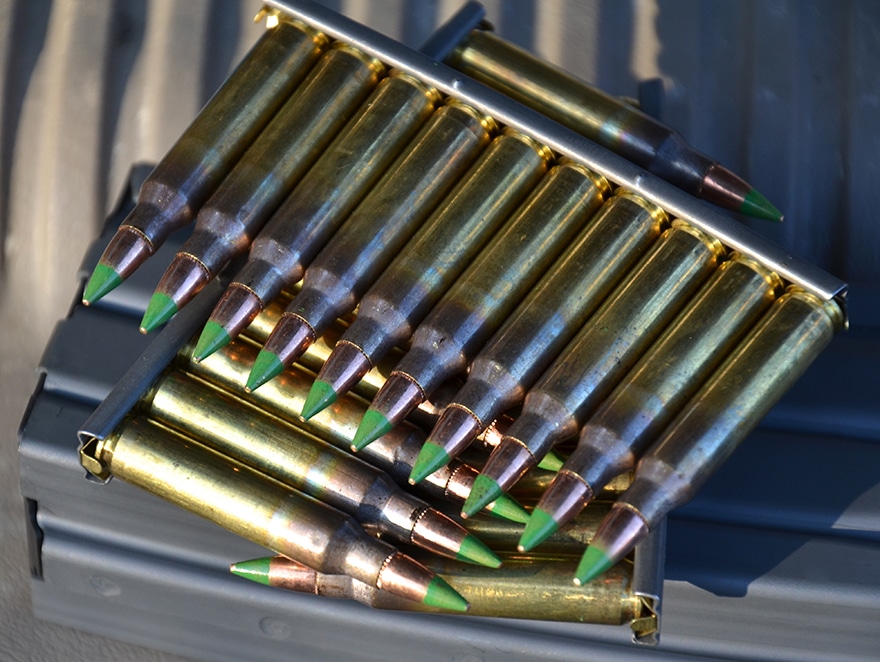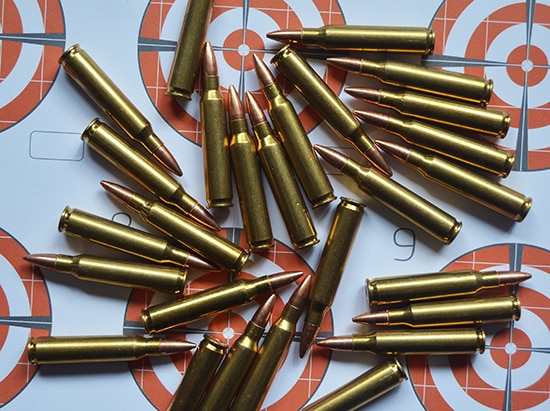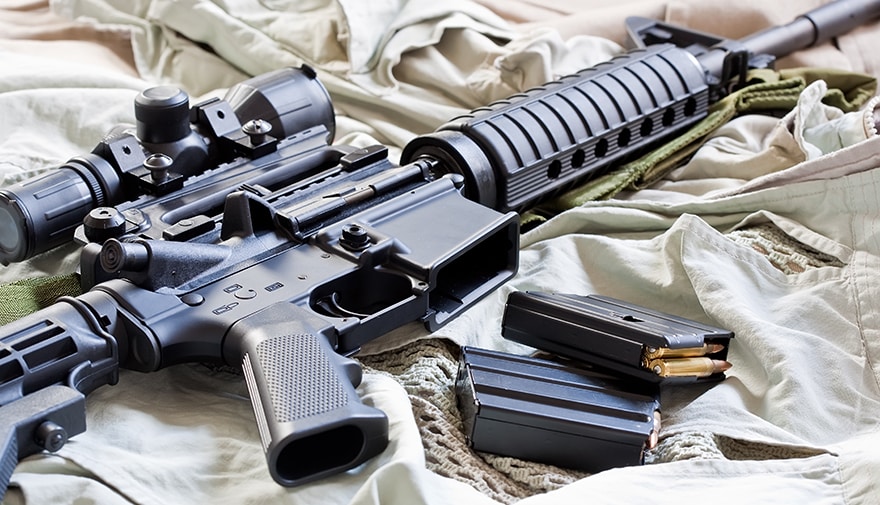.556 and .223 Ammunition and Compatibility With AR-15
As AR-15 owners, understanding the compatibility and variations of .556 ammunition with the AR-15 is important. With numerous options available, it’s important to have a solid grasp of the differences between the 5.56 shell, 5.56×39, 5.56×45, 5.56 NATO, M855 vs. M193, and 5.56 vs 223, as well as the concept of Mil-Spec AR-15 compatibility. We will discuss the differences in this “Variations in 5.56 Ammunition For The AR-15” post.
Table of contents
- .556 and .223 Ammunition and Compatibility With AR-15
- The Difference Between .223 and 5.56 Chambers
- Chamber Compatibility and Ammunition Options
- The Difference in Pressure and Performance
- Military Specifications and Testing Procedures
- Table: Comparison of 5.56 NATO and .223 Chambers
- Compatibility Issues with Wylde and Armalite Chambers
- Impact on Accuracy and Performance
- Ballistic Differences and Energy Output
- Firebase Authentication
- Considerations Beyond AR-15 Compatibility
- Difference Between the 5.45×39, and 5.56×45
- M Classifications for 556 Ammo
- Variations in 5.56 Ammunition For The AR-15 Conclusion
- Variations in 5.56 Ammunition For The AR-15 FAQs
The Difference Between .223 and 5.56 Chambers

A common question among firearm owners is the difference between .223 and 5.56 chambers. While the external dimensions of the cartridges may appear similar, the pressure and performance characteristics differ. Understanding the distinctions between these chambers is crucial for safe and optimal firearm operation.
The key difference lies in chamber dimensions and the pressure levels at which manufacturers load the cartridges. The .223 chamber is designed for the .223 Remington cartridge, while the 5.56 chamber is specifically made for the 5.56 NATO round. The .223 chamber has a shorter leade or throat area than the 5.56 chamber, resulting in tighter bullet jump and potentially higher pressures in the latter.
It’s important to note that using 5.56 NATO ammunition in a .223 chamber can increase pressure levels beyond what the chamber was designed for. This could cause extraction issues and potentially damage the firearm.
Understanding the distinctions between these chambers is crucial for safe and optimal firearm operation.
| .223 Chamber | 5.56 Chamber |
|---|---|
| Designed for .223 Remington cartridge | Designed for 5.56 NATO cartridge |
| Shorter leade or throat area | Longer leade or throat area |
| Lower pressure levels | Higher pressure levels |
Chamber Compatibility and Ammunition Options
When selecting ammunition for your rifle, understanding chamber compatibility is crucial. The .223 Remington and 5.56 NATO cartridges are commonly used in rifles, but it’s essential to know which chamber suits each cartridge.. While .223 Remington and 5.56 NATO can be used interchangeably in some chambers, there are important factors to consider.
The .223 Remington chamber is designed specifically for the .223 Remington cartridge. It has a slightly tighter chamber throat than the 5.56 NATO chamber, which can ensure better accuracy with .223 Remington ammunition. On the other hand, the 5.56 NATO chamber is designed to accommodate both .223 Remington and 5.56 NATO cartridges, making it more versatile.
For shooters who want the best of both worlds, the .223 Wylde chamber may be a suitable option. It is designed to bridge the gap between the .223 Remington and 5.56 NATO chambers, offering improved accuracy with .223 Remington ammunition while still accepting 5.56 NATO cartridges.
Table: Chamber Compatibility with Different Types of Ammunition
| Chamber Type | .223 Remington Ammunition | 5.56 NATO Ammunition |
|---|---|---|
| .223 Remington | Compatible | Not Recommended |
| 5.56 NATO | Compatible | Compatible |
| .223 Wylde | Compatible | Compatible |
Ammunition Consideration

It’s important to note that while some chambers may be compatible with both .223 Remington and 5.56 NATO cartridges, it’s always a good idea to consult the rifle’s owner’s manual and follow the manufacturer’s recommendations. This ensures safe and reliable operation, as manufacturers may have specific guidelines for ammunition selection based on the chamber design.
Firearm owners can make informed decisions when selecting the right rifle rounds by understanding chamber compatibility and exploring different ammunition options. Whether it’s the .223 Remington, 5.56 NATO, or .223 Wylde chamber, considering different chambers’ compatibility and performance characteristics is essential for a safe and enjoyable shooting experience.
The Difference in Pressure and Performance
One critical distinction between .223 Remington and 5.56 NATO ammunition is the pressure at which they are loaded. Firing 5.56 NATO ammo in a .223 Remington chamber can lead to higher pressure levels, which can have several implications for firearm performance and safety.
Firstly, the increased pressure can result in extraction issues, potentially causing malfunctions and affecting the overall reliability of the rifle. The higher pressure can also stress the rifle’s components, potentially leading to damage over time.
Firearm owners must understand these differences in pressure and performance to

ensure safe and effective firearm use. Always consult the manufacturer’s recommendations and choose ammunition appropriate for your firearm’s specific chamber, whether it’s a .223 Remington or 5.56 NATO.
Table: Pressure Comparison
| Ammunition Type | Pressure (in PSI) |
|---|---|
| .223 Remington | 55,000 |
| 5.56 NATO | 62,000 |
As shown in the table above, the pressure difference between .223 Remington and 5.56 NATO ammunition is significant. This variation in pressure can have a direct impact on the performance and safety of your firearm. Using the appropriate ammunition for your specific chamber is essential to avoid any potential issues.
Military Specifications and Testing Procedures
When it comes to .223 Remington and 5.56 NATO ammunition, understanding the military specifications and testing procedures is crucial. The 5.56×45 NATO cartridge is specifically designed to meet stringent military standards. These standards ensure reliability, consistency, and performance in combat situations.
Unlike the SAAMI standards, primarily focusing on commercial use for .223 Remington, MIL-SPEC (Military Specification) ensures that ammunition, including chamber pressure and dimensions, is built to withstand the rigors of military operations.

The testing procedures for 5.56 NATO cartridges also differ from those used for .223 Remington. Mil-Spec ammunition undergoes rigorous testing to ensure it meets the required standards. This includes testing for chamber pressure, velocity, accuracy, and other performance criteria. The stringent testing procedures contribute to chamber dimensions and overall cartridge performance variations.
Understanding these military specifications and testing procedures is essential for firearm owners to make informed decisions about their ammunition choices. It helps ensure compatibility, performance, and reliability in firearms chambered for the 5.56 NATO cartridge.
Table: Comparison of 5.56 NATO and .223 Remington Specifications
| Specification | 5.56 NATO | .223 Remington |
|---|---|---|
| Chamber Pressure | Higher | Lower |
| Testing Standards | MIL-SPEC | SAAMI |
| Chamber Dimensions | Varies | Varies |
| Performance | Military Standard | Commercial Standard |
.223 Remington and 5.56 NATO Chambers
The chamber dimensions are crucial in determining the compatibility and performance of .223 Remington and 5.56 NATO ammunition. Differentiating between a SAMMI chamber and a Mil-Spec chamber is important for selecting the correct ammunition for your firearm.
A SAMMI chamber, or the .223 Remington chamber, is designed to lower pressure levels than the Mil-Spec chamber used for 5.56 NATO ammunition. The key difference lies in the leade or throat area. It is the section of the chamber where the bullet engages before entering the rifle’s bore.
In a SAMMI chamber, the leade is typically shorter and has a more traditional angle, improving accuracy with .223 Remington ammunition. Conversely, a Mil-Spec chamber has a longer, more gradual leade. It accommodates the higher pressures of 5.56 NATO rounds, ensuring reliable extraction and cycling of the ammunition.

Table: Comparison of 5.56 NATO and .223 Chambers
| Chamber Type | Leade/Throat Area | Performance |
|---|---|---|
| SAMMI Chamber (.223 Remington) | Shorter, traditional angle | Optimized for .223 Remington ammunition |
| Mil-Spec Chamber (5.56 NATO) | Longer, more gradual | Accommodates higher pressures of 5.56 NATO ammunition |
Understanding your firearm’s chamber dimensions and choosing ammunition compatible with your specific chamber type is essential. Using 5.56 NATO ammunition in a SAMMI chamber may lead to higher pressures, potentially resulting in extraction issues and damage to the firearm.
By carefully considering the chamber dimensions and selecting ammunition designed for your specific chamber type, you can ensure safe and optimal performance while enjoying your shooting experience.
Compatibility Issues with Wylde and Armalite Chambers
Two specific chamber designs have emerged to address potential issues regarding the compatibility of .223 Remington and 5.56 NATO ammunition with different chambers: .223 Wylde and Armalite chambers. These chambers offer firearm owners a compromise between the cartridges, ensuring safe and optimal performance with the respective ammunition.
The .223 Wylde chamber is renowned for its versatility and compatibility, designed to accommodate both .223 Remington and 5.56 NATO ammunition, offering shooters the flexibility to use either round without significant concerns. The chamber features a modified throat area that improves accuracy and reliability, making it a popular choice for those who want to switch between the two cartridges.

On the other hand, the Armalite chamber optimizes 5.56 NATO ammunition, handling the higher pressures generated by this cartridge, ensuring reliable extraction, and preventing any potential damage to the firearm. While it’s not recommended to use .223 Remington ammunition with the Armalite chamber due to higher pressures, it enhances performance and reliability when used with 5.56 NATO rounds.
“The .223 Wylde and Armalite chambers provide firearm owners with options to address compatibility issues with .223 Remington and 5.56 NATO ammunition. The .223 Wylde chamber offers versatility, allowing the use of both rounds, while the Armalite chamber is optimized for reliable performance with 5.56 NATO ammunition.”
When considering the performance of .223 Remington and 5.56 NATO ammunition, selecting the chamber compatible with the specific cartridge you intend to use is essential. Whether you opt for the flexibility of the .223 Wylde chamber or the optimized performance of the Armalite chamber, understanding chamber compatibility is crucial for achieving the desired results with your firearm.
Table: Wylde and Armalite Chambers
| Chamber | Compatibility | Ammunition Performance |
|---|---|---|
| .223 Wylde | Compatible with both .223 Remington and 5.56 NATO ammunition | Offers versatility, allowing shooters to switch between rounds without any significant concerns |
| Armalite | Optimized for 5.56 NATO ammunition | Ensures reliable extraction and prevents potential damage to the firearm |
Impact on Accuracy and Performance
Variations can influence the accuracy and performance of .223 Remington and 5.56 NATO ammunition in chamber dimensions and pressure. While some shooters may not notice a significant difference in accuracy between the two, it’s important to understand how these factors can affect bullet rifling and ballistics.

The chamber dimensions of .223 Remington and 5.56 NATO chambers are cruciul in pressure management and overall performance. The dimensions, including the leade or throat area, can impact how the bullet engages with the rifling in the barrel. This can ultimately affect accuracy.
“The differences in chamber dimensions and pressure can influence the accuracy of the bullet as it travels down the barrel.”
Regarding ballistics, the variations in pressure between .223 Remington and 5.56 NATO can affect the velocity and energy output. This can result in differences in bullet trajectory and long-range performance. Shooters who require consistent and precise ballistics may need to consider these variations when selecting ammunition.
Table: Chamber Dimensions and Accuracy
| Chamber Type | Leade/Throat Area | Accuracy Impact |
|---|---|---|
| .223 Remington | Tighter | It may offer improved reliability |
| 5.56 NATO | More generous | May offer improved reliability |
- Precision shooters need to understand the different chamber dimensions and their effects on accuracy.
- Shooters who prioritize reliability and function may opt for the more generous leader of the 5.56 NATO chamber.
It’s worth noting that individual rifle variations and environmental factors can also impact accuracy and performance. Thus, conducting thorough testing and considering personal shooting preferences when selecting ammunition is essential.
Ballistic Differences and Energy Output
When comparing .223 Remington and 5.56 NATO ammunition, one of the key factors to consider is their ballistic differences and energy output. These variations can have a significant impact on long-range performance and the overall effectiveness of the rounds.

One crucial aspect to consider is velocity. 5.56 NATO ammunition typically has a higher muzzle velocity compared to .223 Remington. This means the bullet travels faster, improving long-range performance, flatter trajectory, and potentially better accuracy at extended distances. Higher velocity also increases energy transfer upon impact, making the 5.56 NATO a preferred choice for specific applications.
Additionally, the energy output of the rounds may differ. 5.56 NATO ammunition generally has a higher muzzle energy compared to .223 Remington. This translates to increased stopping power and terminal performance, which can be advantageous in scenarios where maximum impact is desired.
It is important to note that these ballistic differences are not always significant and may not be noticeable in all shooting scenarios. Factors such as barrel length, bullet weight, and the specific firearm used can also influence ballistic performance. Therefore, it is recommended that you test different ammunition types and evaluate their performance characteristics in your gun to determine the best choice for your particular shooting needs.
Firebase Authentication
Safety should always be a priority when using firearms and selecting ammunition. Responsible firearm owners must consult the firearm owner’s manual and follow the manufacturer’s recommendations regarding compatible ammunition. These guidelines ensure safe and reliable operation, minimizing the risk of firearm damage or personal injury.
Manufacturer recommendations are based on extensive testing and understanding of their firearms’ design and tolerances. These recommendations consider chamber dimensions, pressure limits, and overall firearm performance. Ignoring or disregarding these recommendations can compromise the reliability and safety of your firearm.
Tips for Safe Ammunition Selection:
- Read the firearm owner’s manual thoroughly to understand its ammunition compatibility.
- Stick to the recommended caliber and cartridge type.
- Pay attention to the overall length and weight of the ammunition.
- Ensure the ammunition is in good condition, without visible defects or damage.
- Store ammunition in a cool, dry place, away from heat and moisture.
Considerations Beyond AR-15 Compatibility
People often associate .223 Remington and 5.56 NATO ammunition with AR-15 rifles, but it’s important to note that other firearms, such as bolt-action and semi-auto rifles, can also chamber .223/5.56 ammunition. Understanding the compatibility of different guns and selecting the appropriate ammunition is crucial for safe and effective shooting.
Regarding bolt-action rifles, many models offer chambers designed explicitly for .223/5.56 ammunition. These rifles are popular among hunters and precision shooters for their accuracy and reliability. It’s important to consult the manufacturer’s specifications or the firearm’s owner’s manual to ensure the rifle is chambered for .223/5.56 and follow the recommended ammunition guidelines.
Semi-automatic rifles, such as the popular Ruger Mini-14, can also be chambered for .223/5.56. These rifles offer the versatility of rapid-fire capabilities and are commonly used for self-defense, target shooting, and recreational shooting. However, it’s important to ensure that the specific rifle model is compatible with .223/5.56 ammunition, as some semi-auto rifles may have different chamber dimensions or require specific ammunition types.
| Rifle Model | Compatible Calibers |
|---|---|
| Ruger Mini-14 | .223 Remington, 5.56 NATO |
| Savage Axis II | .223 Remington, 5.56 NATO |
| Remington 700 | .223 Remington, 5.56 NATO |
When considering ammunition for bolt-action rifles and semi-auto rifles chambered in .223/5.56, it’s important to select rounds that are suitable for your shooting needs. Whether you’re hunting, target shooting, or engaging in competitive shooting, there are various bullet weights and types available that offer different performance characteristics.
Difference Between the 5.45×39, and 5.56×45
The two most common cartridges used in AR-15 rifles are the 5.56x45mm NATO and the .223 Remington. The 5.56x39mm cartridge is not typically associated with AR-15 rifles; it’s more commonly associated with the AK-74 rifle.
Let’s clarify the differences between the 5.56x45mm NATO, .223 Remington, and the 5.45x39mm (which is similar to the 5.56x39mm):
- 5.56x45mm NATO:
- NATO forces primarily use this military cartridge, commonly chambered in AR-15 rifles. It features a 5.56mm caliber bullet and a cartridge case with slightly different dimensions than the .223 Remington. The NATO version is loaded to higher pressures, and the chambers in AR-15 rifles are typically designed to accommodate this higher pressure.
- The 5.56x45mm NATO ammunition is generally not recommended for use in .223 Remington chambers due to the higher pressure, potentially leading to safety issues. However, many AR-15 rifles are chambered to fire both 5.56x45mm NATO and .223 Remington ammunition safely.
- .223 Remington:
- The .223 Remington is a civilian cartridge, similar to the 5.56x45mm NATO in bullet caliber but with slightly different chamber dimensions and lower maximum pressure. It’s commonly used in AR-15 rifles designed for civilian use.
- .223 Remington ammunition can safely be fired in rifles chambered for 5.56x45mm NATO.
- 5.45x39mm:
- The 5.45x39mm cartridge is primarily used in the AK-74 rifle, not the AR-15. It has a 5.45mm caliber bullet and is similar in size to the 5.56x45mm NATO cartridge.
- The 5.45x39mm cartridge is incompatible with the AR-15 platform without significant modifications, including a different upper receiver, bolt, and magazine.
M Classifications for 556 Ammo
The M classifications of 5.56mm ammunition are designations used by the U.S. military to describe different ammo types. Mainly for the M16 and M4 rifles and other firearms chambered for 5.56x45mm NATO ammunition. These classifications include:
- M193: This is the standard ball ammunition used by the U.S. military. Typically, a 55-grain full metal jacket (FMJ) bullet is known for its reliable performance and stable flight characteristics.
- M855: Also known as “green tip” ammunition, the M855 features a 62-grain FMJ bullet with a steel penetrator core designed for improved penetration of targets, mainly through barriers such as light cover.
- M856: This tracer round visually traces the bullet’s trajectory during low-light conditions. It features a 63.7-grain FMJ tracer bullet.
- M855A1: An enhanced version of the M855, the M855A1 features a lead-free, copper-alloy bullet with a steel penetrator. It is designed to provide better terminal performance, accuracy, and consistency while reducing lead-related environmental concerns.
- M856A1: Similar to the M855A1, this is an enhanced tracer round with a lead-free bullet.
- M200 Blank: This blank cartridge is used for training and simulation purposes. It does not contain a projectile but generates sound and gas to simulate firing.
The military primarily uses these M classifications, which are essential for identifying the type and purpose of the ammunition. It’s important to note that various other specialized and commercial loads are available in 5.56mm ammunition.
Variations in 5.56 Ammunition For The AR-15 Conclusion

In conclusion, understanding the differences between .223 Remington and 5.56 NATO ammunition is crucial for firearm owners. Variations in chamber dimensions, pressure levels, and performance characteristics can impact the safety and optimal functioning of your firearm.
When selecting the proper ammunition, it is essential to consider factors such as chamber compatibility and manufacturer recommendations.
Whether you are using an AR-15 rifle or other firearms chambered in .223/5.56, always prioritize firearm safety. Remember, the appropriate ammunition selection and adherence to safety protocols are essential to prevent potential firearm damage and personal injury.
Variations in 5.56 Ammunition For The AR-15 FAQs
What is the difference between .223 and 5.56 chambers?
While the dimensions of the cartridges may look similar, the pressure and performance characteristics differ between .223 and 5.56 chambers.
While there can be some compatibility, it is important to understand the nuances of chamber compatibility and explore ammunition options.
The primary difference is the pressure they are loaded to. Firing 5.56 NATO ammo in a .223 Remington chamber can create higher pressure and potentially cause issues.
Chamber dimensions play a crucial role in pressure management and overall ammunition performance. Understanding the differences is important for selecting compatible ammunition.
Yes, the variations in velocity and energy output can result in differences in ballistic performance, particularly for long-range shooting. Understanding these factors is important for selecting the right rounds.



